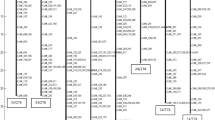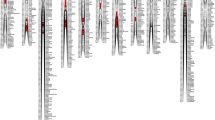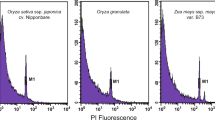Abstract
The Poales (which include the grasses) and Asparagales [which include onion (Allium cepa L.) and other Allium species] are the two most economically important monocot orders. Enormous genomic resources have been developed for the grasses; however, their applicability to other major monocot groups, such as the Asparagales, is unclear. Expressed sequence tags (ESTs) from onion that showed significant similarities (80% similarity over at least 70% of the sequence) to single positions in the rice genome were selected. One hundred new genetic markers developed from these ESTs were added to the intraspecific map derived from the BYG15-23×AC43 segregating family, producing 14 linkage groups encompassing 1,907 cM at LOD 4. Onion linkage groups were assigned to chromosomes using alien addition lines of Allium fistulosum L. carrying single onion chromosomes. Visual comparisons of genetic linkage in onion with physical linkage in rice revealed scant colinearity; however, short regions of colinearity could be identified. Our results demonstrate that the grasses may not be appropriate genomic models for other major monocot groups such as the Asparagales; this will make it necessary to develop genomic resources for these important plants.




Similar content being viewed by others
References
Ahn S, Tanksley S (1993) Comparative linkage maps of the rice and maize genomes. Proc Natl Acad Sci USA 90:7980–7984
Ahn S, Anderson JA, Sorrells ME, Tanksley SD (1993) Homoeologous relationships of rice, wheat and maize chromosomes. Mol Gen Genet 241:483–490
Arumuganathan K, Earle ED (1991) Nuclear DNA content of some important plant species. Plant Mol Biol Rep 9:208–218
Bennetzen JL (2000) Comparative sequence analysis of plant nuclear genes: microcolinearity and its many exceptions. Plant Cell 12:1021–1029
Bennetzen JL, Freeling M (1993) Grasses as a single genetic system: genome composition, colinearity and compatibility. Trends Genet 9:259–261
Bennetzen JL, Ramakrishna W (2002) Numerous small rearrangements of gene content, order and orientation differentiate grass genomes. Plant Mol Biol 48:821–827
Binelli G, Ginafranceschi L, Pe M, Taramino G, Busso C, Stenhouse J, Ottaviano E (1992) Similarity of maize and sorghum genomes as revealed by maize RFLP probes. Theor Appl Genet 84:10–16
Blanc G, Wolfe K (2004a) Functional divergence of duplicated genes formed by polyploidy during Arabidopsis evolution. Plant Cell 16:1679–1691
Blanc G, Wolfe K (2004b) Widespread paleopolyploidy in model plant species inferred from age distributions of duplicate genes. Plant Cell 16:1667–1678
Blanc G, Barakat A, Guyot R, Cooke R, Wolfe K (2000) Extensive duplication and reshuffling in the Arabidopsis genome. Plant Cell 12:1093–1101
Bonierbale MW, Plaisted RL, Tanksley SD (1988) RFLP maps based on a common set of clones reveal modes of chromosomal evolution in potato and tomato. Genetics 120:1095–1103
Boutin S, Young N, Olson T, Yu Z, Shoemaker R, Vallejos C (1995) Genome conservation among three legume genera detected with DNA markers. Genome 38:928–937
Bowers J, Chapman B, Rong J, Paterson A (2003) Unravelling angiosperm genome evolution by phylogenetic analysis of chromosomal duplication events. Nature 422:433–438
Bremer K (2000) Early Cretaceous lineages of monocot flowering plants. Proc Natl Acad Sci USA 97:4707–4711
Brunner S, Keller B, Feuillet C (2003) A large rearrangement involving genes and low-copy DNA interrupts the microcollinearity between rice and barley at the Rph7 locus. Genetics 164:673–683
Chase M, Duvall M, Hills H, Conran J, Cox A, Eguiarte L, Hatwell K, Fay M, Caddick R, Cameron K, Hoot S (1995) Molecular systematics of Lilianae. In: Rudall P, Crib P, Culter D, Humphries C (eds) Monocotyledons: systematics and evolution. Royal Botanic Gardens, Kew, pp 109–137
Chase MW, Soltis DE, Soltis PS, Rudall PJ, Fay MF, Hahn WH, Sullivan S, Joseph J, Molvray M, Kores PJ, Givnish TJ, Sytsma KJ, Pires JC (2000) Higher-level systematics of the monocotyledons: an assessment of current knowledge and a new classification. In: Wilson K, Morrison S (eds) Monocots: systematics and evolution (vol 1). CSIRO, Melbourne, pp 3–16
Chen M, SanMiguel P, Bennetzen JL (1998) Sequence organization and conservation in Sh2/A1-homologous regions of sorghum and rice. Genetics 148:435–443
Devos KM, Chao S, Li QY (1994) Relationship between chromosome 9 of maize and wheat homeologous group 7 chromosomes. Genetics 138:1287–1292
Devos K, Beales J, Nagamura Y, Sasaki T (1999) Arabidopsis-rice: will colinearity allow gene prediction across the eudicot–monocot divide? Genome Res 9:825–829
Dubcovsky J, Luo MC, Zhong GY, Bransteitter R, Desai A, Kilian A, Kleinhofs A, Dvorak J (1996) Genetic map of diploid wheat, Triticum monococcum L., and its comparison with maps of Hordeum vulgare L. Genetics 143:983–999
Dunford RP, Kurata N, Laurie DA, Money TA, Minobe Y, Moore G (1995) Conservation of fine-scale DNA marker order in the genomes of rice and the Triticeae. Nucleic Acids Res 23:2724–2728
FAO (2002) World production and trade statistics. http://apps.fao.org/.
Fischer D, Bachmann K (2000) Onion microsatellites for germplasm analysis and their use in assessing intra- and interspecific relatedness within the subgenus Rhizirideum. Theor Appl Genet 101:153–164
Force A, Lynch M, Pickett F, Amores A, Yan Y, Postlethwait J (1999) Preservation of duplicate genes by complementary, degenerative mutations. Genetics 151:1531–1545
Fu H, Dooner HK (2002) Intraspecific violation of genetic colinearity and its implications in maize. Proc Natl Acad Sci USA 99:9573–9578
Gale MD, Devos KM (1998) Comparative genetics in the grasses. Proc Natl Acad Sci USA 95:1971–1974
Goff SA et al (2002) A draft sequence of the rice genome (Oryza sativa L. ssp. japonica). Science 296:92–100
Havukkala IJ (1996) Cereal genome analysis using rice as a model. Curr Opin Genet Dev 6:711–714
Higgins D, Thompson J, Gibson T, Thompson JD, Higgins DG, Gibson TJ (1994) CLUSTAL W: improving the sensitivity of progressive multiple sequence alignment through sequence weighting, position-specific gap penalties and weight matrix choice. Nucleic Acids Res 22:4673–4680
Ilic K, SanMiguel P, Bennetzen JL (2003) A complex history of rearrangement in an orthologous region of the maize, sorghum, and rice genomes. Proc Natl Acad Sci USA 100:12265–12270
King JJ, Bradeen JM, Bark O, McCallum JA, Havey MJ (1998) A low-density genetic map of onion reveals a role for tandem duplication in the evolution of an extremely large diploid genome. Theor Appl Genet 96:52–62
Klein PE, Klein RR, Vrebalov J, Mullet JE (2003) Sequence-based alignment of sorghum chromosome 3 and rice chromosome 1 reveals extensive conservation of gene order and one major chromosomal rearrangement. Plant J 34:605–621
Kuhl JC, Cheung F, Yuan Q, Martin W, Zewdie Y, McCallum J, Catanach A, Rutherford P, Sink KC, Jenderek M, Prince JP, Town CD, Havey MJ (2004) A unique set of 11,008 onion (Allium cepa) ESTs reveals expressed sequence and genomic differences between monocot orders Asparagales and Poales. Plant Cell 16:114–125
Labani R, Elkington T (1987) Nuclear DNA variation in the genus Allium L. (Liliaceae). Heredity 59:119–128
Li W, Gill BS (2002) The colinearity of the Sh2/A1 orthologous region in rice, sorghum and maize is interrupted and accompanied by genome expansion in the Triticeae. Genetics 160:1153–1162
Liu H, Sachidanandam R, Stein L (2001) Comparative genomics between rice and Arabidopsis shows scant collinearity in gene order. Genome Res 11:2020–2026
Lynch M, Conery J (2000) The evolutionary fate and consequences of duplicate genes. Science 290:1151–1155
Manly KF, Cudmore RH Jr, Meer JM (2001) Map Manager QTX, cross-platform software for genetic mapping. Mamm Genome 12:930–932
Maughan P, Saghai-Maroof M, Buss G (1996) Molecular-marker analysis of seed weight: genomic location, gene action, and evidence for orthologous evolution among three legume species. Theor Appl Genet 93:574–579
Mayer K et al (2001) Conservation of microstructure between a sequenced region of the genome of rice and multiple segments of the genome of Arabidopsis thaliana. Genome Res 11:1167–1174
Moore G (1995) Cereal genome evolution: pastoral pursuits with “Lego” genomes. Curr Opin Genet Dev 5:717–724
Moore R, Purugganan M (2003) The early stages of duplicate gene evolution. Proc Natl Acad Sci USA 100:15682–15687
Ori D, Fritsch RM, Hanelt P (1998) Evolution of genome size in Allium (Alliaceae). Plant Syst Evol 210:57–86
Paterson A, Lan T, Reischmann K (1996) Toward a unified genetic map of higher plants, transcending the monocot–dicot divergence. Nat Genet 14:380–382
Paterson A, Bowers J, Chapman B (2004) Ancient polyploidization predating divergence of the cereals, and its consequences for comparative genomics. Proc Natl Acad Sci USA 101:9903–9908
Pereira M, Lee M, Bramel-Cox P, Woodman W, Doebley J, Whithus R (1994) Construction of an RFLP map in sorghum and comparative mapping with maize. Genome 37:236–243
Rudall P, Furness C, Chase M, Fay M (1997) Microsporogeneisis and pollen sulcus type in Asparagales (Lilianae). Can J Bot 75:408–430
Salse JM, Piegu B, Cooke R, Delseny M (2004) New in silico insight into the synteny between rice and maize highlights reshuffling and identifies new duplications in the rice genome. Plant J 38:396–409
Sasaki T et al (1994) Toward cataloguing all rice genes: large-scale sequencing of randomly chosen rice cDNAs from a callus cDNA library. Plant J 6:615–624
Schuelke M (2000) An economic method for the fluorescent labeling of PCR fragments: a poor man[a]s approach to genotyping for research and high-throughput diagnostics. Nat Biotechnol 18:233–234
Shigyo M, Tashiro Y, Isshiki S, Miyazaki S (1996) Establishment of a series of alien monosomic addition lines of Japanese bunching onion (Allium fistulosum L.) with extra chromosomes of shallot (Allium cepa L. Aggregatum group). Genes Genet Syst 71:363–371
Song R, Llaca V, Messing J (2002) Mosaic organization of orthologous sequences in grass genomes. Genome Res 12:1549–1555
Stajner N, Bohanec B, Javornik B (2002) Genetic variability of economically important Asparagus species as revealed by genome size analysis and rDNA ITS polymorphisms. Plant Sci 162:931–937
Tanksley SD et al (1992) High density molecular linkage maps of the tomato and potato genomes. Genetics 132:1141–1160
Tanksley SD, Bernatzky R, Lapitan NL, Prince JP (1988) Conservation of gene repertoire but not gene order in pepper and tomato. Proc Natl Acad Sci USA 85:6419–6423
Tarchini R, Biddle P, Wineland R, Tingey S, Rafalski A (2000) The complete sequence of 340 kb of DNA around the rice Adh1-Adh2 region reveals interrupted colinearity with maize chromosome 4. Plant Cell 12:381–392
Thiel T, Michalek W, Varshney RK, Graner A (2003) Exploiting EST databases for the development and characterization of gene-derived SSR-markers in barley (Hordeum vulgare L.). Theor Appl Genet 106:411–422
Tikhonov A, SanMiquel P, Nakajima Y, Gorenstein N, Bennetzen J, Avramova Z (1999) Colinearity and its exceptions in orthologous adh regions of maize and sorghum. Proc Natl Acad Sci USA 96:7409–7441
USDA (2002) Onion statistics. http://usda.mannlib.cornell.edu/reports/nassr/price
Van Heusden AW, van Ooijen JW, Vrielink-van Ginkel R, Verbeek WHJ, Wietsma WA, Kik C (2000) A genetic map of an interspecific cross in Allium based on amplified fragment length polymorphism (AFLP) markers. Theor Appl Genet 100:118–126
Weeden N, Muehlbauer F, Ladizinsky G (1992) Extensive conservation of linkage relationships between pea and lentil genetic maps. J Hered 83:123–129
Whithus R, Doebley J, Lee M (1992) Comparative genome mapping of sorghum and maize. Genetics 132:1119–1130
Wong GK, Wang J, Tao L, Tan J, Zhang J, Passey DA, Yu J (2002) Compositional gradients in Gramineae genes. Genome Res 12:851–856
Xin Z, Chen J, Burke J (2004) A low cost high efficient method for genetic mapping using indel markers. Poster abstract 227. Plant and Animal Genomes 12 Conference, San Diego. http://www.intl-pag.org/12/abstracts/P3b_PAG12_227.html
Yan HH, Mudge J, Kim DJ, Shoemaker RC, Cook DR, Young ND (2004) Comparative physical mapping reveals features of microsynteny between Glycine max, Medicago truncatula, and Arabidopsis thaliana. Genome 47:141–155
Yu J et al (2002) A draft sequence of the rice genome (Oryza sativa L. ssp. indica). Science 296:79–92
Zhao Q et al (2002) A fine physical map of the rice chromosome 4. Genome Res 12:817–823
Acknowledgements
This work was completed in compliance with the current laws governing genetic experimentation in Japan, New Zealand, and USA and was supported by U.S. Department of Agriculture, Initiative for Future Agriculture and Food Systems Grant 2001-04434 and Grant-in-Aid for Young Scientists (No. 40314827) from the Ministry of Education, Culture, Sports, Science and Technology, Japan.
Disclaimer: Names are necessary to report factually on available data; however, the U.S. Department of Agriculture (USDA) neither guarantees nor warrants the standard of the product, and the use of the name by USDA implies no approval of the product to the exclusion of others that may also be suitable.
Author information
Authors and Affiliations
Corresponding author
Additional information
Communicated by W.R. McCombie
Electronic supplementary material
Rights and permissions
About this article
Cite this article
Martin, W.J., McCallum, J., Shigyo, M. et al. Genetic mapping of expressed sequences in onion and in silico comparisons with rice show scant colinearity. Mol Genet Genomics 274, 197–204 (2005). https://doi.org/10.1007/s00438-005-0007-6
Received:
Accepted:
Published:
Issue Date:
DOI: https://doi.org/10.1007/s00438-005-0007-6




